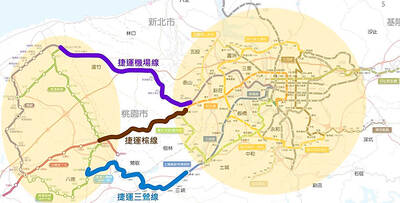Apart from collecting tolls from motorists, the electronic toll collection (ETC) system now has another function: assisting police in catching speeding drivers.
By examining data collected by the ETC system’s gantries in September and October, the National Freeway Bureau was able to identify motorists who exceeded the maximum speed limit by 60kph, bureau Deputy Director-General Wu Mu-fu (吳木富) said.
Driving at such speeds is considered a serious speeding offense under the Road Traffic Management and Penalty Act (道路交通管理處罰條例).
The maximum speed limit on freeways is 110kph, Wu said.
“When a car passes through a gantry, the gantry will register the time. Then you look at when the same car passes through the next gantry and you get the time it took for the car to travel between two gantries. Dividing the distance between the gantries by the travel time, you get the average speed at which the car was moving,” Wu said, explaining how the bureau identified speeding drivers.
The bureau then conducted a cross-analysis of a list of 31 top speeding drivers identified by the ETC system and those caught by the National Highway Police Bureau in September and October.
The result showed that 14 of the drivers on the list had been given tickets by the highway police for speeding.
According to the freeway bureau, four of the motorists on the list had been driving at speeds exceeding 240kph, with one of them driving at 247kph.
Looking at the ETC list and the police record, the motorists were driving at an average of 207kph.
The freeway bureau does not have authority to punish these speeding drivers, Wu said, adding that only highway police have the authority to crack down on speeding drivers.
However, the freeway bureau can provide information that can help highway police station personnel in certain sections of freeways and the time period when speeding is most likely to occur, he said.
The ETC data showed that speeding drivers were mostly found in the northbound sections between Dajia (大甲) and Yuanli (苑裡) and between Jhulin (竹林) and Guangsi (關西) on the Formosa Freeway (Freeway No. 3), as well as the overpass connecting Wugu (五股) and Yangmei (楊梅) along the Sun Yat-sen Freeway (Freeway No. 1).
Speeding was more likely to occur during off-peak and late-night hours, the data showed.
The license plates of the 31 speeding drivers will not be given to the highway police in compliance with the Personal Information Protection Act (個人資料保護法), Wu said.
Drivers found to have exceeded the speed limit by 60kph face a maximum fine of NT$24,000 and immediate suspension of their license for three months, the freeway bureau said.
Speeding drivers found to be at fault in a collision will have their licenses revoked, it said.
The fine could rise to NT$30,000 to NT$90,000 if two or more drivers were found to be racing on freeways, it said, adding that their licenses will be revoked immediately.

“China is preparing to invade Taiwan,” Deputy Minister of Foreign Affairs Francois Wu (吳志中) said in an exclusive interview with British media channel Sky News for a special report titled, “Is Taiwan ready for a Chinese invasion?” the Ministry of Foreign Affairs said today in a statement. The 25-minute-long special report by Helen Ann-Smith released yesterday saw Sky News travel to Penghu, Taoyuan and Taipei to discuss the possibility of a Chinese invasion and how Taiwan is preparing for an attack. The film observed emergency response drills, interviewed baseball fans at the Taipei Dome on their views of US President

The Central Weather Administration (CWA) today issued a "tsunami watch" alert after a magnitude 8.7 earthquake struck off the Kamchatka Peninsula in northeastern Russia earlier in the morning. The quake struck off the east coast of the Kamchatka Peninsula at 7:25am (Taiwan time) at a depth of about 19km, the CWA said, citing figures from the Pacific Tsunami Warning Center. The CWA's Seismological Center said preliminary assessments indicate that a tsunami could reach Taiwan's coastal areas by 1:18pm today. The CWA urged residents along the coast to stay alert and take necessary precautions as waves as high as 1m could hit the southeastern

ECONOMIC BENEFITS: The imports from Belize would replace those from Honduras, whose shrimp exports have dropped 67 percent since cutting ties in 2023 Maintaining ties with Taiwan has economic benefits, Ministry of Foreign Affairs officials said yesterday, citing the approval of frozen whiteleg shrimp imports from Belize by the Food and Drug Administration (FDA) as an example. The FDA on Wednesday approved the tariff-free imports from Belize after the whiteleg shrimp passed the Systematic Inspection of Imported Food, which would continue to boost mutual trade, the ministry said. Taiwan’s annual consumption of whiteleg shrimps stands at 30,000 tonnes, far exceeding domestic production, the ministry said. Taiwan used to fill the gap by importing shrimps from Honduras, but purchases slumped after Tegucigalpa severed diplomatic ties with Taiwan

The Executive Yuan yesterday approved a southwestern extension of the Sanying MRT Line from New Taipei to Bade District (八德) in Taoyuan, with a goal of starting construction by late 2026. The 4.03-kilometer extension, featuring three new stations, will run from the current terminus at Yingtao Fude Station (LB12) in New Taipei City to Dannan Station (LB14), where it will connect with Taoyuan’s Green Line, New Taipei City Metro Corp said in a statement. This extension will follow the completion of core Sanying Line, a 14.29-kilometer medium-capacity system linking Tucheng (土城), Sansia (三峽)